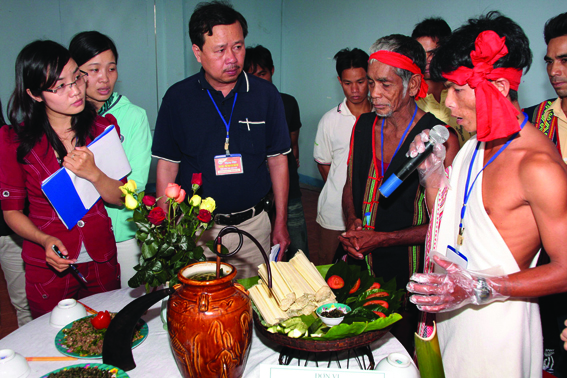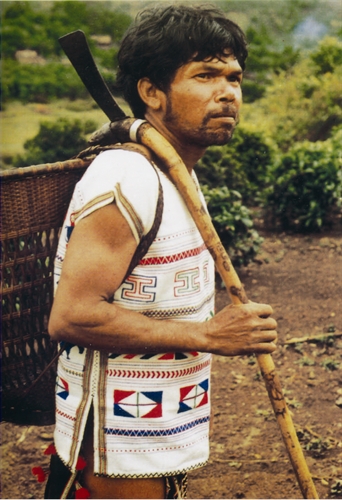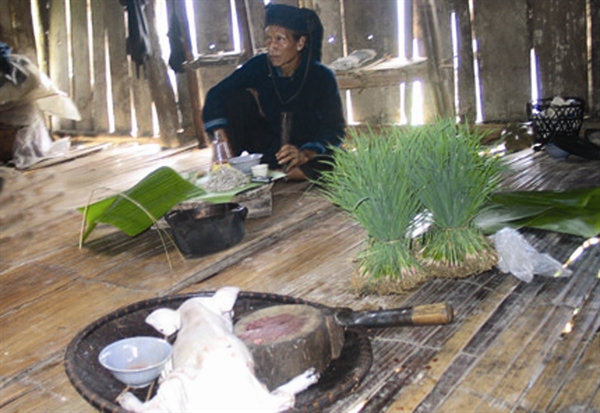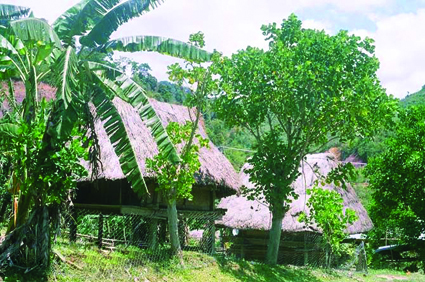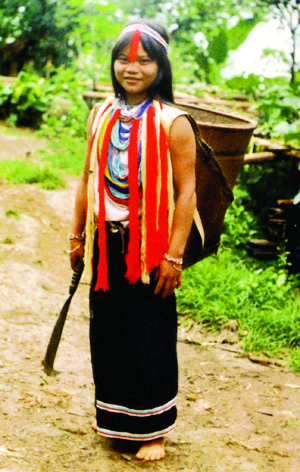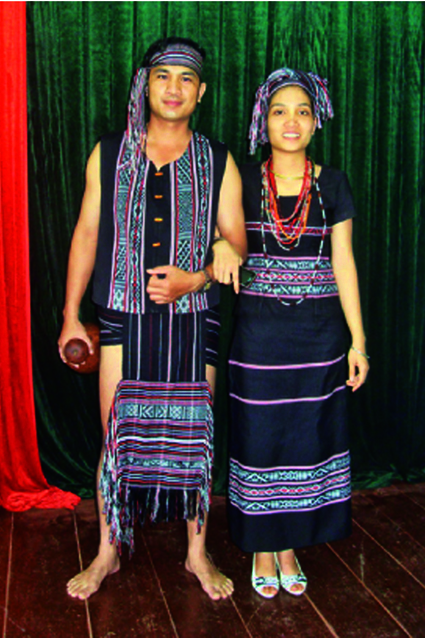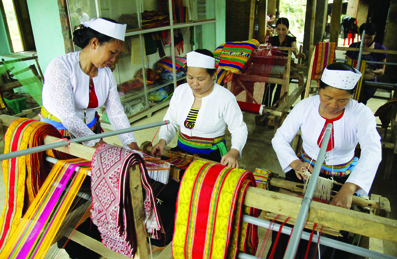>>Customs and practices of Brau ethnic minority
Ta Thi Tam
Ethnology Institute
The Brau is one of the smallest ethnic groups living in the Central Highlands province of Kon Tum with a population of some 400.
Ancestors of this Mon-Kh’mer language group came from southern Laos and northeastern Cambodia, migrating to Vietnam around 150 years ago.
The group lives in Ngoc Hoi, a flat valley at the feet of Hoi and Ho Nieng mountains and in the basin of Dak Su and Bo Y rivers.
The Brau build their village in a large high area, which is surrounded by a fence to ward off wild beasts.
In the middle of the village is nha rong (communal house) where important community rituals and events are held. Nha rong is an architectural work built with the talent and efforts of all villagers as it symbolizes the culture, spirit and pride of the group. Being a solid wooden stilt-house, nha rong has big props made from hardwood and a high and steep roof carved with beautiful patterns.
 |
| Brau men play gong in “rice into the barn” festival __Photo: Internet |
The Brau’s home is a long stilt-house made from wood and bamboo. It has a simple structure with a pitched roof and two gables decorated with patterns in the shapes of the sun, bird head, hand fan blade and so on. The floor is divided into two parts along the house. The lower part accommodates a stove and water trough. The higher part is for sleeping. Linked with the house through a bamboo bridge is an annex where food, home utilities and farming tools are stored.
The Brau live on farming, growing one rice crop a year on upland areas. The group sows seeds in April and harvests rice in October with low and unstable yields as a result of manual farming which largely depends on weather conditions.
The group also grows other crops such as maize, cassava, gourd, egg-plant, vegetable, banana and melon.
Livestock breeding is important for the Brau as it is the main source of supply of sacrifice in community rituals and other important events such as wedding and funeral. They raise pigs, goats and chickens on a family scale.
Hunting is crucial in the life of every Brau man as this hard and dangerous job not only brings about economic benefits for his family but also is regarded as a measurement of his courage. Hunting can be conducted by the whole village, a group of villagers or individually depending on hunted animals and the hunting area. Hunting tools include crossbow, arrow, lance and different kinds of traps. In the past, elephant hunting was the most important for Brau men to show their manliness and ivory earrings were precious jewelry of Brau women. Excellent elephant hunters were honored in the community. Today, use of ivory to make earrings is no longer popular as hunting of wild animals has been outlawed. At present, some Brau families still keep several pairs of ivory earrings as precious keepsakes.
Picking up forest products is another source of food supply for the group, particularly in lean time or the period between crops. This job is done by women all the year round. Their favorite forest products include bamboo shoot, yam and forest vegetables.
Brau men are good at bamboo weaving which is done after harvest time. The group’s beautifully patterned bamboo products, including pack basket, winnowing basket, pannier and mat, are popular in the region and can be bartered for other goods.
The Brau do not have their own traditional costume as they are not good at making clothes. The group uses clothing made by the Kinh and wears costumes of the Lao or Xo Dang during traditional festivals.
In the past, a Brau had to undergo a ceremony of cua rang (tooth cutting) to be recognized as an adult. A person could not have a lover and get married until he or she went through this formality. This custom no longer exists in the Brau community for they have understood the harm of this backward practice to their health.
The Brau follow endogamy but do not permit marriage between members of the same family line. A Brau girl gets married at the age of 16-18, and a boy at 18-20 but underage marriage is still seen in the community. Young people are free in love but must get parental consent to get married. In a Brau family, the maternal uncle has a decisive voice in the marriage of his nieces and is often the person receiving wedding presents from the groom on behalf of the bride’s family. Before a wedding, the groom’s family asks a matchmaker to bring to the bride’s home betrothal offerings including a pig, some chickens and ruou can (rice wine drunk out of a jar through stalks). The wedding ceremony takes place at the bride’s house but the groom’s must pay all expenses. During the wedding feast, the bride and groom exchange food in the witness of the matchmaker and thank all attending villagers who toast the couple and sing folk songs and play gongs to wish them all the best.
After the wedding, the husband has to stay at his wife’s home for four or five years. When his matrilocal stay ends, the husband asks for permission from his parents-in-law to hold an offering ceremony to their ancestors, seeking their permission for her to become an official member of his family. Only after this ceremony can the husband bring his wife to his home. From then, the couple stays alternately in the husband’s home and the wife’s home for every three years and will only live permanently in one home after the parents of the other die. According to Brau custom, when the wife dies, the husband can marry her sister.
A Brau woman can give birth at home with the help of a village midwife. In the naming ceremony held three or five days after the child birth, the midwife offers wine to the gods and recite prayers, asking the gods to accept the name she gives to the baby. After praying, the midwife drinks the offered wine. If the wine tastes good, it is believed to be the sign of the gods’ consent to the name given. If not, the midwife gives another name and conducts the ceremony again until the name of the child is approved.
A Brau funeral usually lasts two or three days. When a person dies, his family will beat gongs and drums to make it known to villagers. The family put new clothes on the dead person and brings him to the village’s funeral home. The corpse is laid in a coffin made of a tree trunk with his head turning to his home. The top of the coffin is a plank tightly tied to the coffin and sealed with clay. The dead person is buried together with a blanket, his clothes and some articles including a gong, a jar, an axe, a crossbow and some arrows as the assets for him in the other world. The coffin is half-buried in a swallow grave. Four deep holes are dug at the four corners of the grave as they are believed to keep the dead person from returning to trouble the living. During the funeral, villagers drink wine and dance to the beats of gongs to see off the dead. Before leaving, the mourners walk around the grave, crying while splashing wine mixed with chicken blood and throwing chicken livers onto the grave to pray for the dead’s support for his family and villagers.
Following polytheism, the group worships the god of sun (Jang Mat Ngay), god of river (Jang Dak), god of forest (Jang Bri) and god of fate (Jang Bai Phau). The community’s altar dedicated to these gods is a bamboo tree planted at the entrance gate of the village. On the top of the tree is a basket containing offerings which include rice, pig liver, and chicken eggs, feather, legs and wings. Villagers will climb up a small ladder leant against the altar to place the offerings.
The Brau do not have their own script but possess a rich folklore treasure with legends about the creation of the space and humans as well as Brau history and fables and funny tales telling the living philosophy of the group.-
